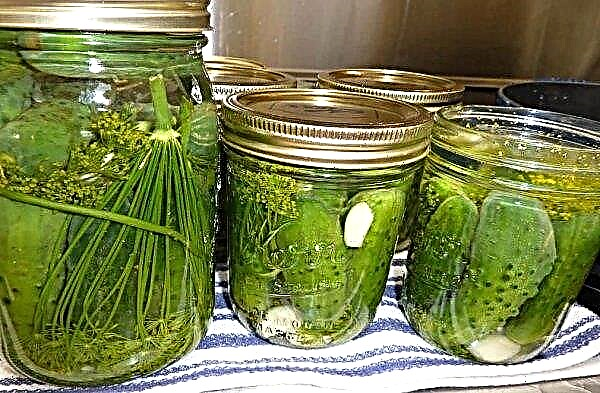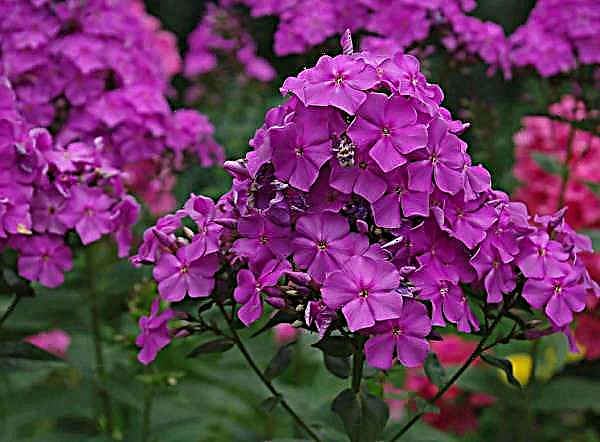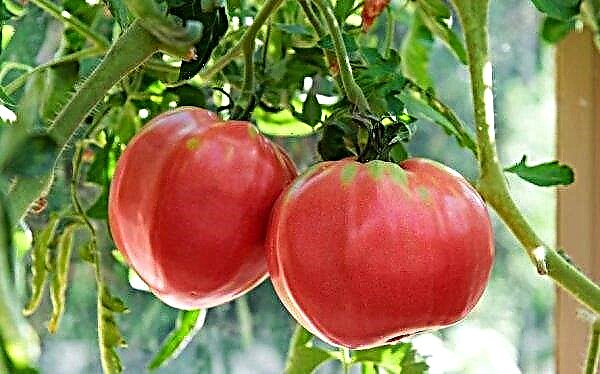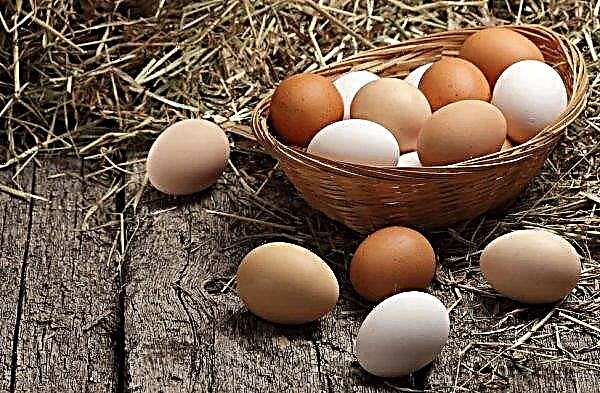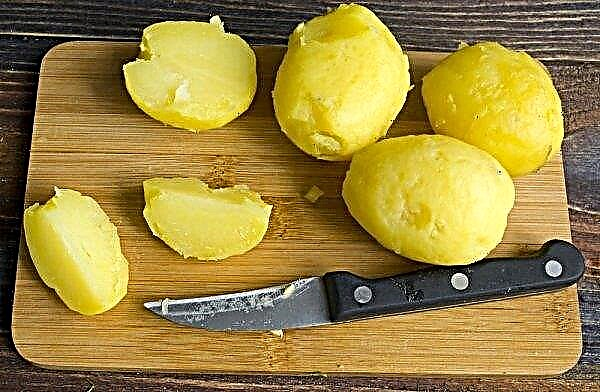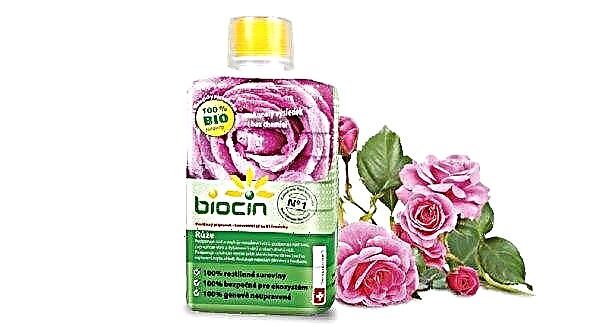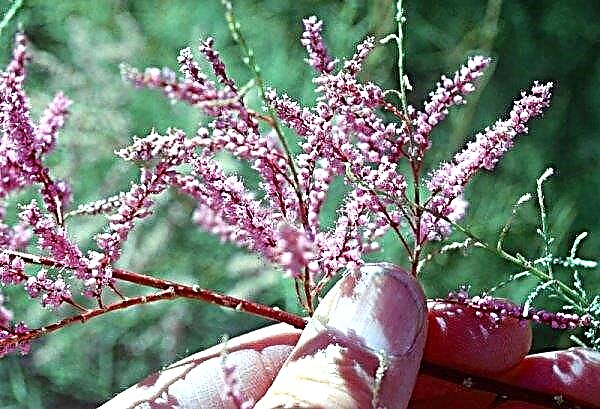Properly selected variety is of great importance for obtaining high tomato productivity. We will introduce you to the advantages, disadvantages and conditions of growing one of the rare, but promising varieties of tomatoes - Rapunzel.
Grade description
The Rapunzel hybrid early ripe tomato variety has 2 characteristic differences from other varieties: it produces very long branches, dense foliage and small cherry fruits. About 40 fruits can be tied on one branch.
This tomato has a strongly developed stem root system, a long and thin stem. The leaves are large, slightly pubescent, dark green in color.

Tomato Rapunzel bears fruit throughout the summer
Other characteristics of this variety are summarized in the table:
| Breeder country | United Kingdom, FloraNova |
| Productivity | High, up to 1 kg per bush |
| Ripening time | 75–80 days after planting |
| Fruit weight | 25 g |
| Bush height | 180–240 cm |
| Fruit color | Bright red |
| Fruit shape | Spherical |
| Pulp | Thick, sweet, juicy, with few cameras |
| Application | For salads and decoration of dishes (not for salting) |
Tomatoes of the Rapunzel variety can be grown both in open ground and in a greenhouse or indoor conditions.
Did you know? The highest tomato tree was grown by the Japanese. In height, it could be compared with a 3-story building.
Advantages and disadvantages
- Tomato "Rapunzel" has the following advantages:
- high level of productivity;
- wonderful taste characteristics of the fruit;
- resistance to most ailments and parasitic insects.
- By cons include:
- unsuitability for long-term savings;
- difficulties in acquiring seeds that are currently not available for direct sale.
Self-growing seedlings
It is better to plant Rapunzel tomatoes by the seedling method. To do this, you need to grow seedlings to the right age, properly care for it, and in the future - transplant to a permanent place of growth.

Optimum timing for sowing
The most favorable period for sowing tomato seeds for seedlings is considered to be mid-March - early April. If you sow seeds at this time, then you need to transplant seedlings to a permanent place in April-May.
The soil
It is better to purchase soil for germinating seedlings in a specialized store. It can also be composed independently of peat (2 parts), garden soil (1 part), humus or compost (1 part) and sand (0.5 parts).
The soil must be decontaminated - treated with potassium permanganate solution, Fitosporin preparation, or calcined in an oven (microwave) at a temperature of 70–90 ° С.
Before sowing seeds, the substrate must be watered and kept in room conditions throughout the day.
Important! If you were not able to get the Rapunzel tomato seeds, then you can try to grow similar varieties of tomatoes, for example, Supersvit 100 F1, Busiki, Apricot Dreams F1, Black Cherry.
Capacity for growing
Prepared soil must be placed in a container for planting seeds. It can be one big box or separate cups from plastic or peat compost. It is necessary to select containers with a depth of at least 10 cm.
Seed preparation
Seeds must be kept in a weak solution of potassium permanganate to disinfect, as well as in a growth stimulator for their early emergence.

Sowing seeds
When sowing seeds in a common box in the substrate, grooves are made with a depth of 0.5 cm. The distance between the seeds should be maintained at 1.5 cm, between the grooves - at 2 cm. 2-3 seeds must be put in one recess. Sprinkle them on top with a 4 mm layer of soil.
The container with seeds should be tightened with a film or covered with glass.
Seedling Care
Seedlings are placed on the windowsill, if possible, then on the south side - there the seedlings will be warm and light. While sprouts appear, it is necessary to maintain the room temperature at 23–25 ° С. If the seedlings do not have enough light during the day, then additional lighting must be equipped.
Seedling care involves daily airing and moistening of the substrate as necessary.

The first sprouts begin to hatch 3-4 days after sowing the seeds. After 7 days, the container with seedlings can be fully opened.
As soon as the plants gave 1-2 real leaf, they need to be planted in different pots with peat. Further care involves regular moisturizing, spraying and hardening. At this stage, the temperature in the room where the seedlings are grown should be 18–20 ° С in the daytime and 12–15 ° С in the night.
When the 5th leaf appeared, seedlings should be watered every 3-4 days. Daylight hours at this time are maintained at 14-16 hours. If necessary, another dive into deeper containers is allowed.
Sprouts during the development can be fertilized 2-3 times with mineral additives.
Seedling hardening
Around mid-late April, if the weather is warm outside, you need to begin the process of hardening seedlings. This is necessary so that the bushes grow strong, resistant to adverse conditions, diseases and pests.
The first procedure should last about 5 minutes. In the future, every day, the hardening duration will need to be gradually increased.
After 1.5 months after sowing, at the age of 45-50 days, the sprouts will be ready for planting in the garden.

Planting seedlings in a permanent place
In the greenhouse or in the open ground, seedlings need to be planted when the weather is cool and cloudy, from about May 25 to June 10. Before planting, it is advisable to measure the temperature of the soil - it should be at least 18 ° C.
A distance of 35–40 cm must be maintained between the bushes. Planting patterns of 40 × 60 or 50 × 60 are used. The recommended row spacing is 50-60 cm. The depth of one landing hole is 10 cm.
The stems are buried in the soil for a couple of centimeters. After planting, the plants are watered with warm water, 1.5–2 liters of water should be poured into each well.
Important! Seedlings, from which the highest yields are obtained, should have thick stems 20-30 cm tall, 3-4 pairs of large leaves, well-developed rhizomes and buds.
When planting in open ground, the first time it will be necessary to cover the seedlings with a film. Also, young sprouts must be insulated if the air temperature is below 17 ° C.
If you are going to grow tomatoes on the balcony, then for this you need to purchase special containers.
How to care
Tomato care “Rapunzel” involves standard steps for caring for plants in the garden:
- watering;
- top dressing;
- garter
- loosening and weeding the soil;
- hilling;
- stepsoning.
Watering
After the seedlings have been planted in a permanent place, after 12 days you need to start watering. The first hydration can be carried out together with the preventive treatment of late blight, pouring a solution of potassium permanganate (2 g / 10 l of water).
Before the buds begin to bloom, it will be necessary to spend about 4 liters of water per 1 sq. m. And during flowering and the formation of ovaries - up to 12 liters.

It must be remembered that tomatoes do not tolerate waterlogging - this contributes to the development of diseases caused by fungi, threatens the appearance of cracks on the fruits and the deterioration of their taste. In turn, insufficient moisture leads to the fact that the ovaries are crumbled and small fruits are formed.
Water the tomatoes only with warm water - no colder than 20 ° C. It must be defended or collected after precipitation.
The procedure is carried out 1-2 times in 7 days. The best time to moisturize is in the evening, after the sun sets, or a couple of hours before sunset. It should be watered so that water does not fall on the foliage and stems.
The optimum humidity for growing tomatoes is 85–90%.
Tomatoes can be watered manually - using a hose (under the root, excluding moisture from plants) - and a drip subsoil method.
Important! You can find out if tomatoes are watered enough by squeezing a lump of earth in the palm of your hand taken from a depth of 10 cm. A well-molded and disintegrating lump indicates sufficient moisture.
The best watering for tomatoes is drip. It can be carried out with the help of plastic bottles in which large and small holes are pre-made and the bottom is cut. Such bottles are placed in wells with a depth of 10–15 cm at a distance of 15–20 cm from the stem at an angle of 30–40 ° and are buried with earth. The liquid poured into the bottles gradually leaves the soil and saturates the roots with moisture. Using these bottles is also convenient to apply fertilizer.
It is important not to forget about spraying - it is better to carry out them together with foliar top dressing and antifungal treatments.
Top dressing
It is recommended to carry out 4 top dressing of tomatoes:
- the first - 2 weeks after planting;
- the second - 10 days after the first;
- the third - 2 weeks after the second;
- the fourth - 20 days after the third.

For feeding tomatoes suitable drugs:
- "Gumi Kuznetsova";
- Gumat-Universal;
- "Emerald",
- "Ideal" and others.
Fertilizing tomatoes is produced after abundant hydration. Root dressing must be alternated with foliar. After the ovaries are formed, fertilizer can be applied only under the root.
Did you know? For a long period, residents of America and Europe considered tomatoes unsuitable for food due to toxicity. The fact that these fruits are edible, it became known only after the American Robert Gibbon Johnson in 1820 publicly ate a bucket of red tomatoes.
Stepson
In a tomato bush, as it grows, many side shoots or stepsons are formed. Their large number leads to thickening of plantings, contributes to the development of ailments caused by fungi, the formation of small fruits or their late ripening. In order to avoid these problems, stepsoning is carried out - the removal of lateral shoots growing in the axils of the leaves. They are cut off with their hands or cut off with scissors, leaving "stumps" of 5 cm each. As a result, only one main stem should remain.
The sooner additional stepchildren are removed, the better the crop will be able to get.
It is necessary to conduct stepsoning 1-2 times a week.

Soil care
The soil under plantings requires regular care. After each watering and rainfall, it is cultivated and cultivated. This must be done carefully so as not to harm the root system.
In order not to produce loosening, you can mulch the soil. For this, mowed grass is suitable. Mulching will also allow weed control and drying out of the soil.
Hilling is optional. Each gardener decides for himself whether to do it or not.
If necessary, the aisles should be cleaned of weeds - they are removed along with the roots.
Bush tying
Since Rapunzel tomatoes form tall stems, they must be tied up. This will protect them from damage under the weight of the fruit.
For this purpose, pegs of 1 m in height are driven in at a distance of 10-15 cm from the stem. Stems are tied to them with a rope.

Preventative treatment
Although Rapunzel tomatoes are resistant to major diseases and parasites, if they are not properly maintained and cared for, they can be sick with fungal diseases, be affected by aphids, Colorado potato beetles, teddy bears, May beetles, wireworms. In order to prevent diseases, it is necessary to adhere to recommendations on the conditions for growing tomatoes.
To prevent the development of late blight, spraying is used with garlic infusion, decoction of pine shoots, as well as treatment in the first week after planting with preparations containing copper, Fitoftorin-M, Oksikhom.
In order to prevent such an ailment as a mosaic of tomatoes, they spray with a mixture of 1 teaspoon of urea with 1 liter of milk.
Against the black leg, they use treatment with a solution of calcium nitrate, a decoction of onion peels, and copper-containing fungicides.
Leaf mold disease can be avoided by treating 1 tablespoon of grated laundry soap and 1 tablespoon of copper sulphate dissolved in 1 bucket of water.

Vertex decay is fought with a solution of calcium nitrate.
To prevent the invasion of pests, mixed plantings are used. So, in the immediate vicinity of tomatoes in the aisles you need to plant marigold, marigolds, lupins, mustard, oil radish.
Also used against insects are biologics “Bitoxibacillin”, “Actofit”, “Lepidocide”, “Planriz”, “Haupsin”.
Did you know? Botany classifies a tomato as a berry, technological systematics as a vegetable, and, according to EU rules, it is a fruit.
We introduced you to today's rare Rapunzel tomato variety, which certainly deserves the attention of gardeners and lovers of cherry tomatoes. It is suitable for cultivation in various conditions - in the garden, in the greenhouse, on the balcony. The only thing that upsets - now it is quite difficult to find its seeds for sale.

